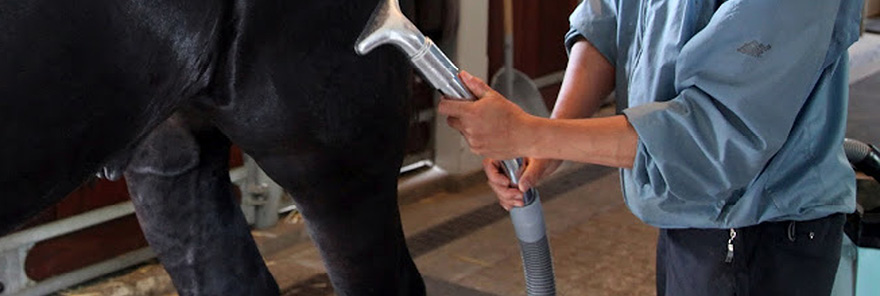We all have the muscles to prove that we’re horsepeople.
Biceps are part of the job description, whether we’re mucking stalls, stacking hay, or just grooming our horses. But every now and then, even the most stalwart horseman can get faced with a horse so indescribably a dirt-ball, not even our own considerable elbow grease is up to the challenge.
In warm weather, high pressure from a hose might do the trick to remove those layers of grime. But if you don’t have time for a bath, or if the temperature has dropped past bathing and drying-time parameters, it might be time to call on technology. Yes, the horse vacuum. Whether you’re considering a horse-only vacuum, or you’re just going to use the shop vac from the tool room, vacuuming a horse can suck up seeming tons of dust, dirt, and hair, and save you plenty of grooming time.
Before you fire up the vacuum, be sure that your horse is okay with the whole idea. Many horses just love being vacuumed, although the odd one will decide it is a roaring dragon from the depths of Hades and head for the hills at one glance. When deciding whether or not it’s worth the time to introduce your horse to a vacuum, consider how he reacts to other loud mechanical devices: body clippers, for example. A horse that goes bananas over a body-clip is almost certainly going to be anti-vacuum. If you frequently use a blower or shop vac in the stable-aisle and he doesn’t cower in the back of his stall, trembling, you’re also already ahead of the game.
But even if you’re dealing with an old pro who shrugs off loud noises, grab a friend for assistance before you start the introductions: “Horse, meet vacuum. Vacuum: horse.” You’re going to show him the machine first, including its scary hoses, and then start all over again showing him the machine turned on (this makes a huge difference) while someone is holding him by a lead-rope. Cross-ties or stall chains are definitely not appropriate until the horse is totally okay with the vacuum, its roar, and its snake-like hoses criss-crossing his body and dragging on the floor.
Once you have a vacuum-broke horse, get the most out of the vacuum’s sucking power by giving the horse a good currying all over. Oh, that’s right, we were supposed to avoid all that labor. Well, the fact is, nothing is good for a horse’s coat and skin like a good rub-down with a curry-comb. And in this case, you’re going to loosen a lot of hair and dust that you can’t see, which means your vacuum session is going to be that much more effective.
Now: to vacuum. Just as when you’re body-clipping, be mindful of sensitive areas and watch that electrical cord. Turn the horse if necessary to keep the electrical cord out from under hooves. Keep the vacuum far away from the face, especially if its high-powered, to avoid potentially serious injuries, and use caution around the flank, belly, or anywhere else your horse is ticklish.
Vacuum your horse in long sweeps, following the flow of the hair, just as you would with a body brush. If you’re using a vacuum that isn’t specifically animal-designed, like a shop vac, you’ll want to use extra caution with the nozzle. These tend to have more suction, so slowly break the suction at the end of each line with a sweeping upwards motion, instead of abruptly pulling the nozzle away.
A light mist of water from a spray bottle can be helpful if your horse’s coat gets a static build-up, especially in dry weather.
The most important thing to remember about vacuuming your horse: watch him and let his behavior be your guide! He’ll tell you which areas are sensitive, and when you’re not being sensitive enough. And don’t let vacuuming become a daily substitute for a good hand-grooming, which is an important part of your horse-care routine. It’s good for your horse, and for you!


